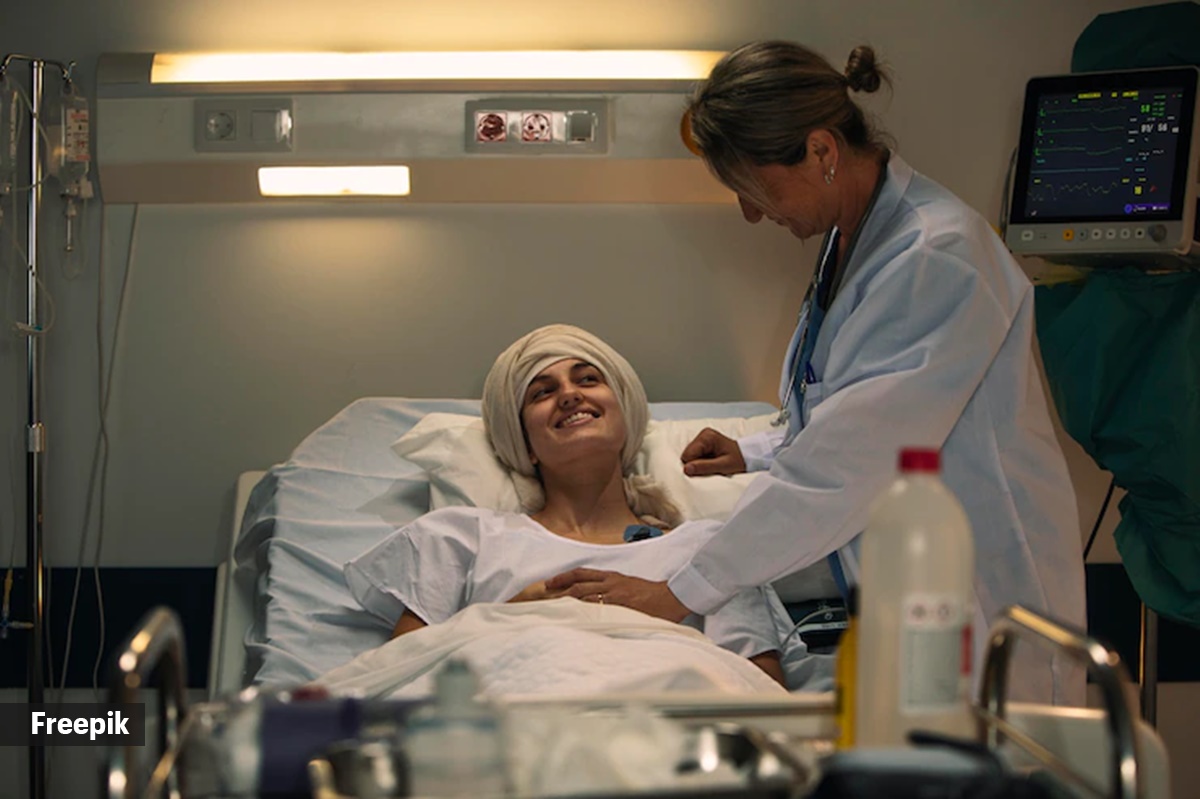World Cancer Day: How simple lifestyle modifications can reduce one’s risk of developing cancer
All your frequently asked questions answered by Dr Kushal Gupta, Dr Gaurav Prakash and Dr Pankaj Malhotra, Dept of Clinical Haematology and Medical Oncology, PGIMER, Chandigarh
 The hereditary or genetic reasons of cancers are seen in about 30 per cent of all cancers like breast, ovarian, colon, pancreas and prostate. (Source: Freepik)
The hereditary or genetic reasons of cancers are seen in about 30 per cent of all cancers like breast, ovarian, colon, pancreas and prostate. (Source: Freepik)Written by Dr Kushal Gupta, Dr Gaurav Prakash, Dr Pankaj Malhotra
The best way to beat cancer is to build awareness about it, improve a basic understanding among the masses so that the fear and stigma related to the diagnosis fades away, encourages more people to go for screening and reach out for medical help. Here are frequently asked questions.
What is cancer?
Normally, the cells of our body multiply or “take birth”, perform a special function and die in a continuous well-regulated manner. Cancer is the unregulated and irregular multiplication of cancerous or “malignant” cells that can form a mass called “tumour” with a potential to migrate to other body parts, a process called “metastasis”. Cancer cells lose the ability of being regulated and governed by our body’s tightly regulated processes that otherwise check their multiplication. Broadly cancers or malignancies can be divided into solid tumour cancers (like lung, breast, kidney, brain, stomach, ovarian, etc) and blood cancers (leukaemias and lymphomas). In fact, there are more than 200 different types of cancers, each with different etiologies as well as different diagnosis and treatment.
How big is the problem in India?
As per a Globocan 2020 report, India that year had around 13.24 lakh new cancer cases (6.46 lakh new cases in men and 6.78 lakh in women) and 8.51 lakh deaths related to cancer. The three most common cancers in men were those of the head and neck region (1.35 lakh new cases), followed by lung cancers (0.72 lakh new cases), and cancers of the gastro-intestinal tract. The three most common cancers in women were breast (1.78 lakh new cases), cervical cancer (1.23 lakh new cases) and ovarian cancer (0.45 lakh new cases). Blood malignancies like leukaemias occupied the seventh spot with 48,419 new cases in 2020, while lymphoma occupied the ninth position with 45,049 new cases. While the increased numbers reported may partly be attributed to improvement in diagnostic healthcare in the last decade, the overall incidence is on the rise with overwhelming numbers of new cancer cases.
What’s the role of alcohol, tobacco, stress and obesity?
It is widely known that smoking causes lung cancer. However, smoking (including passive smoking) can also increase the chances of urinary bladder, oesophagus (“food pipe”), head and neck cancers, and kidney cancer. Tobacco smoke contains around 70 carcinogens (chemicals that can cause cancers), out of a list of total 7,000 chemicals, mostly complex hydrocarbons. Out of all, 33 per cent of all cancers can directly or indirectly be attributed to tobacco use or smoking. Apart from smoking, alcohol abuse is another leading preventable cause of cancer in approximately 25 per cent of cancer patients, mainly causing cancers of liver, head and neck, oesophagus, breast and intestines. Similarly, obesity and lack of physical activity can directly or indirectly cause cancers in up to 20 per cent of all cancers (mainly breast, uterus, intestines, pancreas, kidneys and prostate), while another 16 per cent is caused by cancer causing pathogens and bacteria.
The hereditary or genetic reasons of cancers are seen in about 30 per cent of all cancers like breast, ovarian, colon, pancreas and prostate. In women, the additional factors that can increase cancer risk include delayed first pregnancy, lack of breast-feeding and use of oral contraceptives. In working women especially, work-related stress increases the risk of cancer by up to 70 per cent as compared to women who are not working. The other common man-made causes of cancers include exposure to pesticides and chemicals, exposure to toxic fumes from factories and contaminated natural sources of water. There are other rarer causes of cancer-like exposure to radiation, unhealthy dietary habits and excess exposure to ultraviolet rays from the sun.
What are signs and symptoms?
Although diagnosing cancer in early stages, when it is still curable, is a challenge, there are certain signs and symptoms which, when present, should alert you to seek medical attention from qualified practitioners of modern medicine. The danger signs or “red-flag” signs that should prompt a person to seek medical help are:
- Cough or shortness of breath.
- Persistent headache, vomiting or blurring of vision
- Bleeding from any site, including blood in stools, sputum or urine.
- Hoarseness of voice or sudden change in voice
- A non-healing ulcer in the cheeks, mouth or tongue
- Loss of appetite and early satiety
- A lump in the breast or any other part of the body externally.
- A mole that changes shape size or bleeds on touch.
- Unexplained weight loss and tiredness
- Difficulty in swallowing food or vomiting after having food.
- Changes in fingernails
- Any recurrent or new symptom, the cause of which has not been diagnosed earlier.
What about lifestyle modifications and prevention?
Although there are many non-modifiable causes of cancers, there are also many simple lifestyle modifications that can reduce one’s risk of developing cancer during his/her lifetime.
- Quit smoking and all forms of tobacco addiction.
- Quit alcohol abuse and addiction.
- Avoid second-hand smoke.
- Do physical exercises and yoga, for at least 30 minutes in a day.
- Maintain healthy body weight, as per height.
- Include fruits, juices and green vegetables in your diet regularly.
- Avoid excess of red-meat (mutton, lamb, pork, beef) and processed meats (sausages, ready-to-cook preserved meat and fish)
- Avoid excess of canned and artificially preserved foods
- Avoid stress or relieve it by developing hobbies, playing with pets.
- Adequate sleep, at least seven to nine hours per day.
- Avoid unnecessary exposure to bio-hazardous radiation
- Avoid use of uncertified non-food grade plastics cups and cutlery.
- Try to consume certified organic food, fruits and vegetables.
- Use ample turmeric and garlic while cooking food.
When should you screen for cancer?
 As per a Globocan 2020 report, India that year had around 13.24 lakh new cancer cases (6.46 lakh new cases in men and 6.78 lakh in women) and 8.51 lakh deaths related to cancer. (Source: Freepik)
As per a Globocan 2020 report, India that year had around 13.24 lakh new cancer cases (6.46 lakh new cases in men and 6.78 lakh in women) and 8.51 lakh deaths related to cancer. (Source: Freepik)
Screening means the clinical examination and diagnostic investigations directed at detecting and diagnosing cancers even before the appearance of signs and symptoms. In India, considering the complexities involved in delivering population based-cancer screening programmes and the diversity of health system capabilities with in different regions in India, the National Cancer Grid (NCG), a consortium of more than 180 cancer institutions in India, in consultation with the Government of India and Indian Council of Medical Research (ICMR) has laid some guidelines for early detection programmes in breast, cervical and oral cancers.
- Breast cancer Screening
- Breast Self-Examination: Done by the woman herself, it includes examination of all parts of her breasts and armpits, so that any change is noticed immediately. It is recommended to check once a month, one week after periods, after age 20 onwards.
- Clinical Breast Examination: It is an examination by a doctor or nurse who checks both breasts and the lymph nodes in armpits. Recommended every three years between 20 and 30 years and every year after 40 years of age.
- Mammography: It is an X-ray of the breast which can find cancer when it is too small to be felt. To be done every one to three years, from age 40 to 65 years, upon the advice of a doctor and based on personal risk factors and available resources. If an abnormality is detected, the doctor may recommend a diagnostic ultrasonography of the affected breast and guided biopsy for further evaluation.
- Oral Cancer Screening
- Oral Visual Inspection (OVI): Done every three years, it consists of oral visual inspection of the mouth of all age groups at high risk of developing oral cancers, especially tobacco users, smokers, alcohol abusers, areca nut and also betel nut users, using incandescent light. If an abnormality is detected, the doctor may recommend examination by a specialist like ENT/dental surgeon and also diagnostic oral biopsy or brush cytology for further evaluation.
- Cervical Cancer Screening
- Visual inspection using five per cent acetic acid /Lugol’s Iodine (VIA/VILI): Done at least twice in a lifetime between ages 30 and 49 years, visual inspection with acetic acid (VIA) is simple, non-invasive and inexpensive visual test, has an easy-to-learn approach, does not require laboratory involvement, is a real time test with results available immediately. Even non-physicians can be trained to perform the procedure.
- Pap test (Papanicolou test): This is a proven and time-tested procedure, done in women between 25 to 65 years of age, that includes examination of a cervical smear under microscope and has led to early detection of pre-cancerous lesions and has successfully been employed to decrease rates of cervical cancer.
- HPV testing (Human Papilloma Virus testing): If available, cervical cancer screening with HPV test alone can be done every five years for everyone with a cervix from age 25 until age 65. If HPV testing alone is not available, people can get screened with an HPV/Pap combined test every 5 years or a Pap test every 3 years.
What are treatment options?
Treatment of cancers depends on the stage of the cancer, the fitness of the patient and other considerations like concomitant illnesses — diabetes and hypertension. Treatment modalities have conventionally comprised chemotherapy, surgery and radiation therapy. However, as medical science advances, newer modalities of cancer treatment like targeted therapies and immuno-therapies have been introduced. Treatment of a particular patient, with a particular stage of cancer at diagnosis, is planned and tailored by a team of experts in a Multi-Disciplinary team (MDT) meetings, also known as Tumour Boards. MDTs in most hospitals comprise a Medical Oncologist (who plans treatment using chemotherapies, hormonal therapies, immunotherapies, targetted therapies and other systemic therapies), a Surgical Oncologist (who takes decision on possibilities of surgery), a Radiation Oncologist (who plans treatment using ionizing radiations), and a Palliative Care physician (who looks after the pain control and palliative measures to support treatment).
For treatment of blood cancers, newer modalities of treatment, apart from conventional chemotherapies, that are at various stages of trials, include CAR-T Cell therapy and immunotherapy. As each cancer patient is different, the approach for this treatment is also similarly customised to deliver best possible and optimised results, aimed at cure or palliation, with minimum possible toxicity and side-effects.
📣 For more lifestyle news, follow us on Instagram | Twitter | Facebook and don’t miss out on the latest updates!



- 01
- 02
- 03
- 04
- 05




























